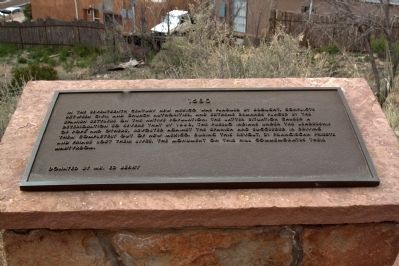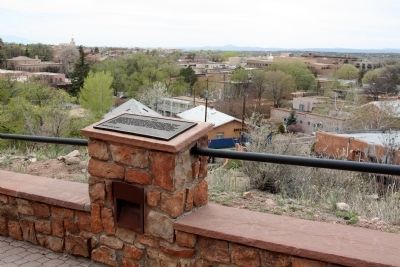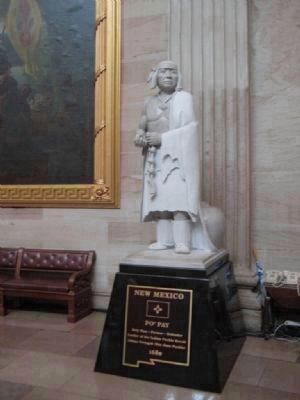Santa Fe in Santa Fe County, New Mexico — The American Mountains (Southwest)
1680
— Commemorative Walkway Park —
Erected 1986 by Mr. Ed. Berry. (Marker Number 5.)
Topics. This historical marker is listed in these topic lists: Churches & Religion • Colonial Era • Native Americans. A significant historical year for this entry is 1680.
Location. 35° 41.373′ N, 105° 56.005′ W. Marker is in Santa Fe, New Mexico, in Santa Fe County. Marker can be reached from Paseo de Peralta near Otero Street. It is at Hillside Park. Touch for map. Marker is in this post office area: Santa Fe NM 87501, United States of America. Touch for directions.
Other nearby markers. At least 8 other markers are within walking distance of this marker. 1610 (a few steps from this marker); 1692 (a few steps from this marker); 1776 (a few steps from this marker); 1862 (a few steps from this marker); 1848 (a few steps from this marker); 1598 (within shouting distance of this marker); 1912 (within shouting distance of this marker); 1926 (within shouting distance of this marker). Touch for a list and map of all markers in Santa Fe.
Related markers. Click here for a list of markers that are related to this marker. This is a list of all 21 markers on Santa Fe’s Commemorative Walkway at Hillside Park. There is a link on the list to a map of all markers on the walkway.
Also see . . .
1. Wikipedia Entry for the Pueblo Revolt of 1680. “Popé promised that, once the Spanish were killed or expelled, the ancient Pueblo gods would reward them with health and prosperity. Popé’s plan was that the inhabitants of each Pueblo would rise up and kill the Spanish in their area and then all would advance on Santa Fe to kill or expel all the remaining Spanish. The date set for the uprising was August 11, 1680. Popé dispatched runners to all the Pueblos carrying knotted cords. Each morning the Pueblo leadership was to untie one knot from the cord, and when the last knot was untied, that would be the signal for them to rise against the Spaniards in unison. On August 9, however, the Spaniards were warned of the impending revolt by southern Tiwa leaders and they captured two Tesuque Pueblo youths entrusted with carrying the message to the pueblos. They were tortured to make them reveal the significance of the knotted cord.” (Submitted on August 13, 2014.)
2. Wikipedia Entry for Popé. “As stated by Matthew Martinez of Po’pay’s home Pueblo, Ohkay Owingeh, ‘it took a unique individual to orchestrate the revolt across two dozen communities who spoke six different languages and were sprawled over a distance of nearly 400 miles.’ What little we know of Po’pay the man is distorted through the lenses of the Spanish chroniclers and their Indian informants, most of whom were opposed to Po’Pay.
“Both the Spanish and the Pueblos were decimated
by the revolt and its aftermath. However, what can be said with certainty is that the relations between Spanish and the Pueblos was far different after the revolt than before. The dreaded encomienda system (forced labor) was prohibited in New Mexico. Franciscan priests did not interfere with Pueblo religious ceremonies provided that the Pueblos observed the outward forms of Catholicism. Pueblo warrior and Spanish soldier became allies in the fight against their common enemies, the Apaches, Navajo, Utes, and a new and even greater threat to the survival of New Mexico, the Comanche. Thus, New Mexico became a blend of Spanish and Pueblo culture.” (Submitted on August 13, 2014.)
3. About Santa Fe » Santuarios & Religious Sites » Cross of the Martyrs. “Walking up this paved trail you may notice circular fireplaces with remnants of charred coals. The fireplaces are lit with farolitos or bonfires when, during the first week in September, the city sponsors the oldest community gathering of its kind in the country, the ìFiesta de Santa Fe.î This Fiesta was inaugurated in 1692 to celebrate the peaceful
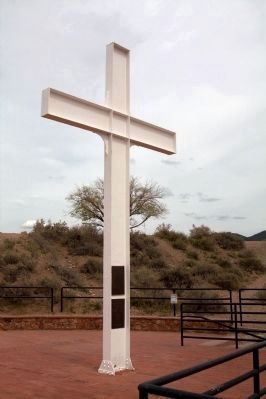
Photographed By J. J. Prats, April 18, 2014
4. Cross of the Martyrs Monument
This cross is at the terrace at the top of the walkway. Take a look at the satellite view on the introductory marker page for this series “375th Anniversary of Santa Fe” for a satellite view of this walkway with the location of this cross.
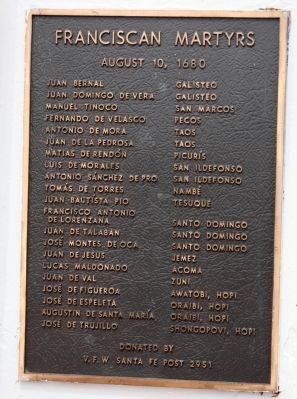
Photographed By J. J. Prats, April 18, 2014
5. First of Two Plaques on the Cross of the Martyrs Monument
The plaque lists the 21 martyrs and the mission where they were posted. It reads, “Franciscan Martyrs, August 10, 1680. • Juan Bernal, Galisteo • Juan Domingo de Vera, Galisteo • Manuel Tinoco, San Marcos • Fernando de Velasco, Pecos • Antonio de Mora, Taos • Juan de la Pedrosa, Taos, • Matias de Rendón, Picurís • Luis de Morales, San Ildefonso • Antonio Sánchez de Pro, San Ildefonso • Tomás de Torres, Nambé • Juan Bautista Pio, Tesuque • Francisco Antonio de Lorenzana, Santo Domingo • Juan de Talaban, Santo Domingo • José Montes de Oca, Santo Domingo • Juan de Jesus, Jemez • Lucas Maldonado, Acoma • Juan de Val, Zuni • José de Figueroa; Awatobi, Hopi • José de Espeleta; Oraibi, Hopi • Augustin de Santa María; Orabi, Hopi • José de Trujillo; Shongopovi, Hopi • Donated by V.F.W. Santa Fe Post 2951.”
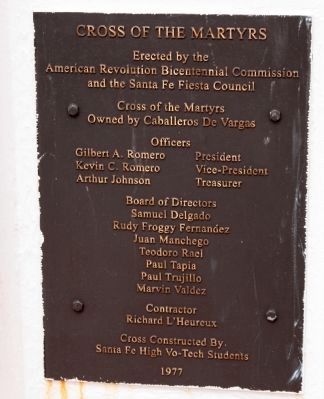
Photographed By J. J. Prats, April 18, 2014
6. Second of Two Plaques on the Cross of the Martyrs Monument
The plaque reads, “Cross of the Martyrs. Erected by the American Revolution Bicentennial Commission at the Santa Fe Fiesta Council. Cross of the Martyrs is owned by Caballeros de Vargas. Officers: Gilbert A. Romero, President; Kevin C. Romero, Vice-President; Arthur Johnson, Treasurer. Board of Directors: Samuel Delgado, Rudy Froggy Fernandez, Juan Manchego, Teodoro Rael, Paul Tapia, Paul Trujillo, Marvin Valdez. Contractor: Richard L’Heureux. Cross constructed by Santa Fe High Vo-Tech Students, 1977.”
Credits. This page was last revised on September 24, 2020. It was originally submitted on August 13, 2014, by J. J. Prats of Powell, Ohio. This page has been viewed 1,608 times since then and 46 times this year. Photos: 1, 2, 3. submitted on August 13, 2014, by J. J. Prats of Powell, Ohio. 4, 5, 6. submitted on August 16, 2014, by J. J. Prats of Powell, Ohio.
Editor’s want-list for this marker. A photograph of the Cross of the Martyrs showing the city below. • A photograph from a vantage point in the city showing the Cross of the Martyrs in the distance • Can you help?
